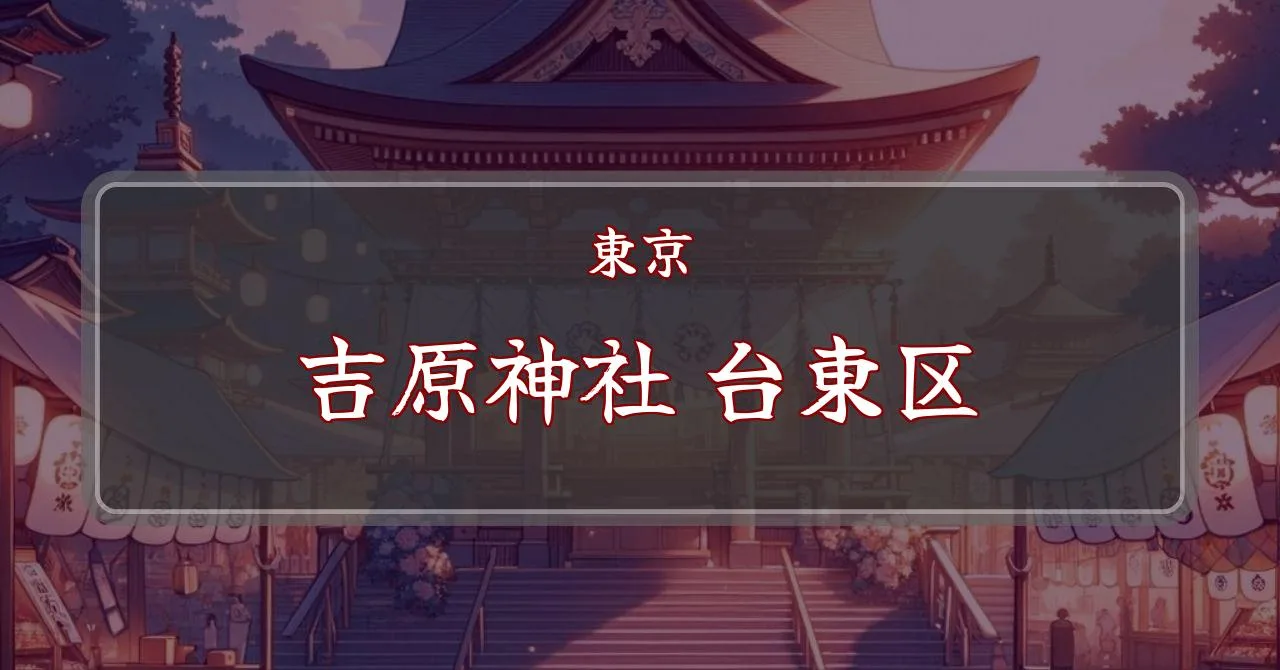吉原神社例大祭2025:狐面行列と神輿渡御!浅草の熱気あふれる伝統祭
イベントの概要
東京都台東区千束にある吉原神社では、2025年も例大祭が開催されます。浅草神社の三社祭とほぼ同時期に行われるこの例大祭は、古くから新吉原遊郭の鎮守として信仰されてきた吉原神社の重要な年中行事です。 最大のハイライトは、土曜日の夕刻に行われる本社神輿の渡御行列。行列の先頭には、地元吉原の「吉原狐社中」と呼ばれる狐の面をかぶった人々が参加し、独特の雰囲気を醸し出します。彼らは、隣接する千束稲荷神社の例大祭でも狐神楽を奉納するほど、地域に深く根付いた伝統芸能を担っています。 神輿渡御以外にも、境内宮神輿の渡御や狐舞、山車など、様々な伝統的な神事が行われ、浅草の街に活気と賑わいをもたらします。 吉原神社のご祭神は稲荷神・倉稲魂命(うかのみたまのみこと)と弁天様・市杵嶋姫命(いちきしまひめのみこと)。開運、商売繁昌、技芸上達のご神徳があるとされ、多くの人々が参拝に訪れます。 明治5年(1872年)に、新吉原遊郭に古くから鎮座していた玄徳稲荷社と、廓内四隅の守護神である稲荷社5社を合祀して創建された吉原神社。浅草七福神のひとつ、弁財天も合祀されている歴史ある神社です。例大祭では、その歴史と伝統を感じることができるでしょう。 境内では、音声による神社と遊郭の歴史解説も行われ、歴史に興味のある方にもおすすめです。 2025年の例大祭の日程は、浅草神社の三社祭と同様に5月に行われる予定です。(※具体的な日程は吉原神社公式ホームページ等でご確認ください)。 吉原神社例大祭は、伝統と歴史、そして現代の活気が融合した、忘れられない体験となるでしょう。ぜひ、浅草の街を訪れ、この熱気に満ちたお祭りを体感してみてください。
基本情報
- 開催日: 2025年5月(具体的な日程は吉原神社公式ホームページ等でご確認ください)
- 開催時間: 9:30~16:30 (拝観時間。例大祭の具体的な時間は吉原神社公式ホームページ等でご確認ください)
- 住所・開催場所: 東京都台東区千束3-20-2 吉原神社
- アクセス: JR「上野駅」から地下鉄日比谷線「三ノ輪駅」徒歩15分
- お問い合わせ先: 吉原神社 03-3872-5966
- 関連ホームページ: http://yoshiwarajinja.tokyo-jinjacho.or.jp/
主なイベント
吉原神社例大祭の主なイベントは、伝統的な神事と、地域住民が参加する賑やかな行列です。浅草神社の三社祭とほぼ同時期に開催されるため、浅草全体が祭りムードに包まれます。吉原神社の歴史と、かつてこの地に存在した新吉原遊郭の面影を感じさせる独特の雰囲気も魅力です。
本社神輿渡御
例大祭のハイライトと言えるのが、土曜日の夕刻に行われる本社神輿の渡御行列です。威勢の良い掛け声と、神輿を担ぐ人々の力強い姿は、見ている者を圧倒する迫力があります。行列には、地元吉原の「吉原狐社中」と呼ばれる狐の面をかぶった人々も参加し、独特の雰囲気を醸し出します。この狐面行列は、吉原神社例大祭の象徴的な光景であり、他の祭りでは見られない珍しいものです。 行列のルートは、吉原神社周辺の地域を巡行し、沿道には多くの見物客が集まります。神輿の渡御は、地域住民の結束を象徴するものであり、古くからの伝統が現代に受け継がれていることを実感できるでしょう。 神輿渡御の際には、沿道で神輿の安全を祈願する人々の姿も見られ、地域全体が一体となって例大祭を盛り上げている様子が分かります。 神輿渡御は、単なる行列ではなく、地域住民の信仰心と、吉原神社の歴史と伝統を肌で感じることができる貴重な体験です。
- 内容:吉原神社の本社神輿が地域を巡行する行列
- 特徴:吉原狐社中による狐面行列が参加し、独特の雰囲気を醸し出す
- 見どころ:力強い神輿渡御と、狐面行列の幻想的な光景
境内宮神輿渡御
本社神輿渡御以外にも、境内にある宮神輿の渡御も行われます。規模は本社神輿ほど大きくありませんが、境内を賑やかに練り歩く様子は、例大祭の活気を感じさせる重要なイベントです。 境内宮神輿の渡御は、本社神輿渡御と同様に、地域住民の信仰心と、吉原神社の歴史と伝統を肌で感じることができる貴重な体験です。 神輿の担ぎ手たちは、神輿を丁寧に運び、神聖な雰囲気を保ちながら、境内を巡行します。 境内宮神輿の渡御は、本社神輿渡御に比べると規模は小さいものの、境内を活気づけ、例大祭の雰囲気を盛り上げる重要な役割を果たしています。
- 内容:境内にある宮神輿が境内を巡行する
- 特徴:本社神輿渡御と合わせて、例大祭の賑やかさを演出する
- 見どころ:境内を活気づける神輿の動きと、神聖な雰囲気
狐舞
吉原狐社中による狐舞も、例大祭の見どころのひとつです。優雅で神秘的な狐の舞は、古くからの伝統芸能であり、吉原神社例大祭に独特の雰囲気を与えています。 狐舞は、神楽の一種であり、神への奉納として行われます。 狐舞の舞手たちは、狐の面をかぶり、伝統的な衣装を身につけ、神聖な雰囲気の中で舞を披露します。 狐舞は、神聖な儀式であると同時に、観客を魅了する華麗なパフォーマンスでもあります。 狐舞は、吉原神社例大祭の重要なイベントであり、その伝統と歴史を伝える貴重なものです。
- 内容:吉原狐社中による伝統的な狐の舞
- 特徴:優雅で神秘的な舞が、例大祭に独特の雰囲気を与える
- 見どころ:伝統芸能の素晴らしさと、神聖な雰囲気
山車
山車も、例大祭を彩る重要な要素です。華やかな装飾が施された山車は、地域住民の信仰心と、吉原神社の歴史と伝統を表現しています。 山車は、神輿と共に地域を巡行し、沿道の人々を楽しませます。 山車の装飾は、地域独特の特色が反映されており、その地域の歴史や文化を知る上で貴重な資料となっています。 山車は、例大祭の賑やかさを演出するだけでなく、地域住民の結束を象徴するものです。
- 内容:華やかに装飾された山車が、例大祭を彩る
- 特徴:地域住民の信仰心と歴史・伝統を表現
- 見どころ:華麗な装飾と、地域独特の特色
アクセス方法
吉原神社へのアクセスは、JR上野駅から地下鉄日比谷線に乗り換え、三ノ輪駅で下車後、徒歩で約15分です。 公共交通機関を利用するのが便利です。 上野駅からは、比較的アクセスしやすい場所にあります。 三ノ輪駅からは、比較的分かりやすい道順で神社へたどり着けます。 周辺には、浅草などの観光地も点在しているので、観光と合わせて訪れるのも良いでしょう。 徒歩でのアクセスが難しい場合は、タクシーの利用も可能です。
- 電車:JR上野駅→地下鉄日比谷線→三ノ輪駅下車後、徒歩約15分
その他の情報
吉原神社例大祭は、屋外で開催されるため、天候に左右されます。雨天の場合でも、神事は行われる可能性が高いですが、服装や持ち物については、天候に合わせて調整することをお勧めします。 また、例大祭は多くの人で賑わうため、混雑が予想されます。 歩きやすい靴を履いていくことをお勧めします。 水分補給も忘れずに行いましょう。 小さなお子さん連れの場合は、迷子にならないよう、十分に注意してください。 貴重品は、安全に管理しましょう。 マナーを守って、例大祭を楽しみましょう。
- 服装:動きやすい服装がおすすめです。雨天の場合は、雨具の持参をおすすめします。
- 持ち物:水分、タオル、帽子など。雨天の場合は傘。
- その他:混雑が予想されますので、時間に余裕を持って来場ください。
公式情報
吉原神社の公式ウェブサイトやSNSの情報は、例大祭の最新情報や詳細なスケジュールを確認するのに役立ちます。 不明な点があれば、吉原神社へ直接お問い合わせください。
- 関連ホームページ: http://yoshiwarajinja.tokyo-jinjacho.or.jp/
- お問い合わせ先: 吉原神社 03-3872-5966




